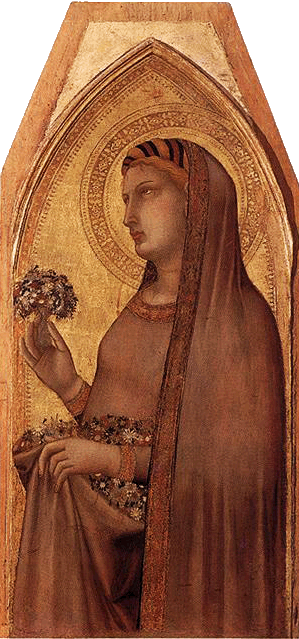In the legend Dorothy lived in the 3rd century in Caesarea in Cappadocia. After a gruesome course of tortures failed to persuade her to worship idols, the provost Fabricius condemned her to death by decapitation. When she was on the way to her martyrdom a jesting "scribe of the realm" named Theophilus asked her to bring him roses and apples from the "Paradise" she claimed she was going to. Then as she proceeded to the execution a mysterious child appeared before her bearing a basket of three roses and three apples (as at right). She asked him to take the basket to Theophilus. The year after she was martyred, in the dead of winter, the child brought the apples and roses to Theophilus, and he converted to Christianity as a result.
For this reason, St. Dorothy's attribute is a basket of roses and apples. Sometimes, as at left, the basket is replaced by her own garment and the apples are omitted. Instead of the basket, or sometimes in addition to it, she may be holding a stalk of three or five roses. In her Byzantine-influenced portrait at St. Mark's, Venice, the basket becomes a stylized circle.
St. Dorothy is almost always pictured with blond hair. As with many other virgin saints, her dress often has a scoop neckline.
Portraits also sometimes show her with the mysterious child, as in the second picture at right. One image labels the child Jesus Christus and gives him the cruciform halo used only for the Divinity. In another somewhat deteriorated fresco in the same church the child is shown once receiving the basket and once delivering it. There are no labels, but the halo on the child receiving the basket seems to have a cross on it. This rendering of the child as Christ most likely responds to Dorothy's words to the child in the Acta Sanctorum (Feb. vol. 1, 774): "Tell him, ‘here is what you asked my spouse to send you from Paradise.’" That is, the flowers are from Christ, allegorically the "spouse" of the just soul.
Dorothy was killed by decapitation.
Prepared in 2014 by Richard Stracke, Emeritus Professor of English, Augusta University. Revised 2015-10-28, 2016-12-21.

Detail from Lorenzetti's Madonna and Child with St. Mary Magdalene and St. Dorothy)

Reliquary monstrance with St. Dorothy and the mysterious child. (See the description page.)
ATTRIBUTES
- Basket of flowers
- Child with a basket and curly golden hair
MORE PICTURES
- Second half of the 14th century: Fragment of a fresco in Ferrara.
- After 1463: Giovanni di Paolo's painting identified as St. Margaret could possibly be St. Dorothy.
- 19th or 20th century: Copy of Franz Ittenback's mid-19th century Heilige Dorothea, in an American mansion.
DATES
- Feast day: February 6
- Caxton and Bokenham (99) date St. Dorothy's death as 288, but Butler (261) has 303.
BIOGRAPHY
- Bokenham, Legends of Holy Women (95-99).
- Dorothy's vita in The Roman Breviary: English translation, I, 752; Latin original, 825
- The Golden Legend: The essay on Dorothy in the Acta Sanctorum refers to Dorothy's Acta in the Golden Legend, but there is nothing about her in Graesse's text of that work, nor in Ryan's translation. Caxton's translation (html or pdf) does have a life of Dorothy, without the etymologies that introduce the lives in Caxton and Graesse. These facts would suggest that Caxton was working from a single exemplar of the Golden Legend to which some lives had already been added, rather than that he himself added Dorothy's life from a completely separate source.
- Butler, 261-62.
- Acta Sanctorum, February vol. 1, 771-76.